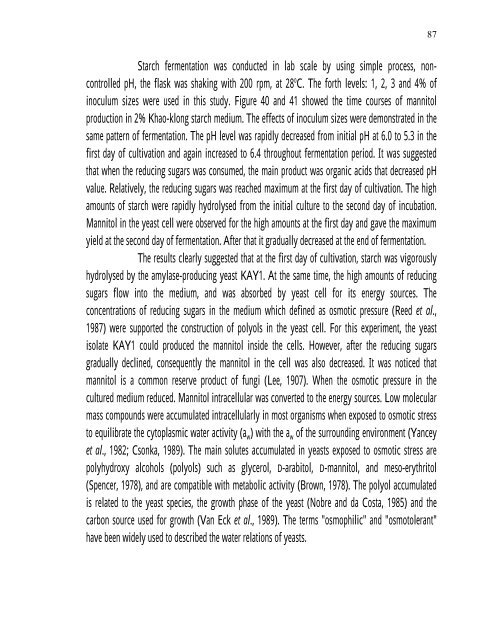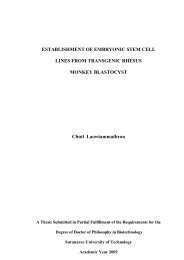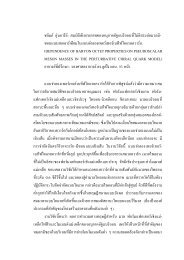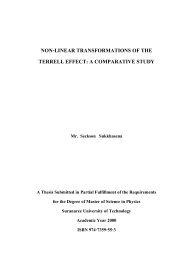PRODUCTION Of NUTRIENT SOURCES FOR RHIZOBIUM
PRODUCTION Of NUTRIENT SOURCES FOR RHIZOBIUM
PRODUCTION Of NUTRIENT SOURCES FOR RHIZOBIUM
You also want an ePaper? Increase the reach of your titles
YUMPU automatically turns print PDFs into web optimized ePapers that Google loves.
Starch fermentation was conducted in lab scale by using simple process, noncontrolled<br />
pH, the flask was shaking with 200 rpm, at 28 o C. The forth levels: 1, 2, 3 and 4% of<br />
inoculum sizes were used in this study. Figure 40 and 41 showed the time courses of mannitol<br />
production in 2% Khao-klong starch medium. The effects of inoculum sizes were demonstrated in the<br />
same pattern of fermentation. The pH level was rapidly decreased from initial pH at 6.0 to 5.3 in the<br />
first day of cultivation and again increased to 6.4 throughout fermentation period. It was suggested<br />
that when the reducing sugars was consumed, the main product was organic acids that decreased pH<br />
value. Relatively, the reducing sugars was reached maximum at the first day of cultivation. The high<br />
amounts of starch were rapidly hydrolysed from the initial culture to the second day of incubation.<br />
Mannitol in the yeast cell were observed for the high amounts at the first day and gave the maximum<br />
yield at the second day of fermentation. After that it gradually decreased at the end of fermentation.<br />
The results clearly suggested that at the first day of cultivation, starch was vigorously<br />
hydrolysed by the amylase-producing yeast KAY1. At the same time, the high amounts of reducing<br />
sugars flow into the medium, and was absorbed by yeast cell for its energy sources. The<br />
concentrations of reducing sugars in the medium which defined as osmotic pressure (Reed et al.,<br />
1987) were supported the construction of polyols in the yeast cell. For this experiment, the yeast<br />
isolate KAY1 could produced the mannitol inside the cells. However, after the reducing sugars<br />
gradually declined, consequently the mannitol in the cell was also decreased. It was noticed that<br />
mannitol is a common reserve product of fungi (Lee, 1907). When the osmotic pressure in the<br />
cultured medium reduced. Mannitol intracellular was converted to the energy sources. Low molecular<br />
mass compounds were accumulated intracellularly in most organisms when exposed to osmotic stress<br />
to equilibrate the cytoplasmic water activity (a w) with the a w of the surrounding environment (Yancey<br />
et al., 1982; Csonka, 1989). The main solutes accumulated in yeasts exposed to osmotic stress are<br />
polyhydroxy alcohols (polyols) such as glycerol, D-arabitol, D-mannitol, and meso-erythritol<br />
(Spencer, 1978), and are compatible with metabolic activity (Brown, 1978). The polyol accumulated<br />
is related to the yeast species, the growth phase of the yeast (Nobre and da Costa, 1985) and the<br />
carbon source used for growth (Van Eck et al., 1989). The terms "osmophilic" and "osmotolerant"<br />
have been widely used to described the water relations of yeasts.<br />
��






